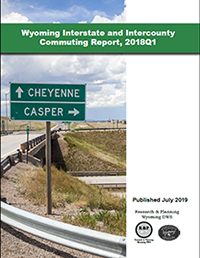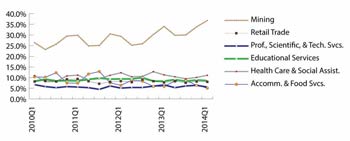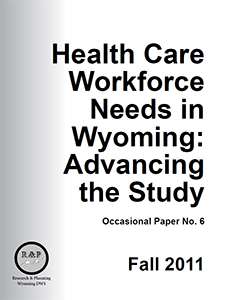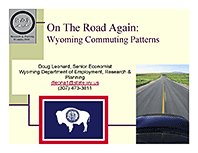Commuting Patterns
Article
An Introduction to Colorado-Wyoming Commuting Patterns
from the 2020 Wyoming Workforce Annual Report
Published June 29, 2020.
Quarterly Report

Wyoming Interstate and Intercounty Commuting Report, 2018Q1
For several years the Research & Planning (R&P) section of the Wyoming Department of Workforce Services has published intercounty commuting patterns that illustrate how many individuals commute to or from another county for work. A new model developed by R&P also provides data on interstate commuting. Using this new model, R&P was able to identify commuting patterns for Wyoming residents working in eight other states: Colorado, Montana, Nebraska, New Mexico, Ohio, South Dakota, Texas, and Utah.
Published July 2019.
Data
Wyoming Interstate and Intercounty Commuting Data
With Longitudinal State and County Data from 1992 to 2018
Current data from other states: 2018Q1.
Current data for Wyoming: 2018Q4.
Published July 2019.
Previous Commuting Reports
From Trends
Understanding How Commuting Flows and Job Losses in Other States Could Affect Wyoming’s Unemployment Rate
Article from the April 2015 issue of Wyoming Labor Force Trends
Interstate Commuting

Selected States' Commuter Rates by Industry, 2010Q1-2014Q1
(Alaska, Colorado, Montana, South Dakota)
Commuting and Health Care
Occasional Paper No. 6
Health Care Needs in Wyoming: Advancing
the Study

Chapter 5: Commuting Impacts on Health Care
(PDF)
This chapter compares and contrasts the demographics of selected health care professions and the commuting behavior of the people who work in those professions. Performing such an analysis serves two important functions: 1) it provides a description of health care professional employment characteristics and associated behaviors, and 2) it demonstrates Research & Planning’s (R&P) ability to synthesize data from several sources to provide a robust description of worker behavior.
Published January 2012.
Cheyenne MPO Report
Laramie County and Colorado Worker Commuting Pattern Analysis
Presented to the Cheyenne Metropolitan Planning Organization June 30, 2008
14 Pages. (145KB PDF)
Research & Planning (R&P) contracted with the Cheyenne Metropolitan Planning Organization (MPO) in 2007 to study Laramie County worker commuting flows. The project’s purpose was to determine not only the amount of commuting into and out of Laramie County, but also the sources and destinations of commuters. Additionally, R&P obtained geographic information for Colorado residents who commute into Wyoming for work. MPO intends to use the information and analysis presented in this report to determine the feasibility of a commuter bus service along the Front Range to transport those who live in Colorado and work in Laramie County to their jobs in a more efficient manner.
2008 Report
The Road to Work:
Commuting in Wyoming

To learn more about where the state’s labor force lives and works, the Research & Planning (R&P) section of the Wyoming Department of Employment developed a commuting pattern data model, in cooperation with the Wyoming Workforce Development Council. This 12-page publication gives examples of R&P commuting pattern data that can be used by business owners, policy makers, economic developers, and others. These findings have many uses, such as identifying sources of labor, housing needs, or pointing to changing infrastructure needs.
Key Findings
- The majority of the increase in commuting inflows since 2003 is due to people who lack a Wyoming driver’s license.
- Wyoming exports people to California, so large inflows from California are consistent with Internal Revenue Service tax return data.
- County inflows can be examined at the industry level by state of origin. Inflows from out of state are much more pronounced in border counties.
The Road to Work (PDF Format) (368 KB)
Presentation
On The Road Again: Wyoming Commuting Patterns
Presented September 13, 2007, at the Wyoming Planning Association 2007 Fall Conference, Douglas, Wyo.

Flows by County
Commuter Flows by County (2007, PDF, 5 Pages, 107KB)

From the executive summary:
The data generated from the Wyoming Worker Commuting Patterns Study identify relationships between where people choose to live and where they choose to work, as evidenced by employer/employee transactions. As Wyoming’s economic growth continues, worker commuting will likely increase and it may well be that a portion of demand for labor in one county can be met by strategically engaging residents from other counties and states.
Other Commuting Research and Articles







 Hire Wyo
Hire Wyo